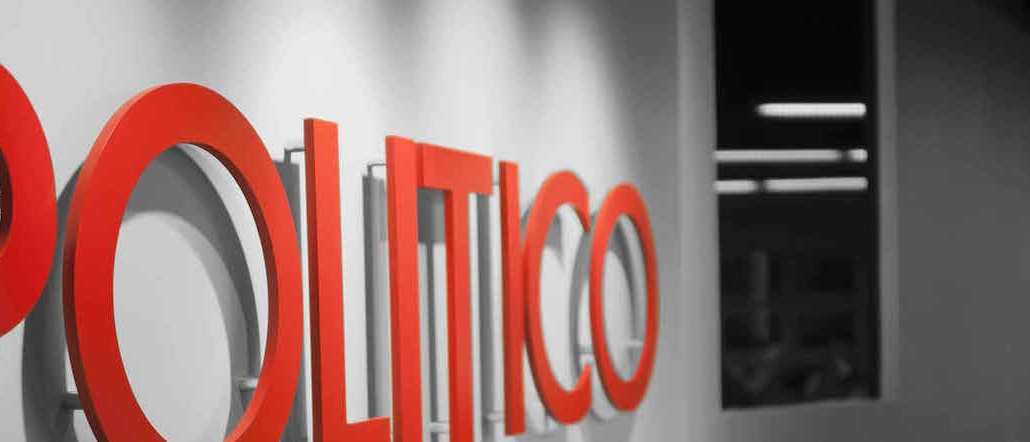Save 50% on a 3-month Digiday+ membership. Ends Dec 5.
Politico’s Brexit strategy will become blueprint for future expansion plays

Politico may be a niche title, but its European expansion has been fast.
Its newsroom expansion in London and Brussels this year put it in a strong position to capitalize on the surge in the public’s interest in politics after the EU Referendum fallout. A blend of carefully timed Brexit-related editorial and new distribution methods gave its traffic a timely 300 percent boost in June: to 2.7 million visitors and 6.3 million pageviews. Twenty percent of that came from the U.K., according to Adobe Omniture.
Its Brexit strategy will now become a blueprint for all future expansion plays, according to one of its chief instigators: Kate Day, Politico Europe’s editorial director of audience development and growth.
“We hadn’t laid much of a base in the U.K. [audience-wise] before Brexit. For Politico, it was a great opportunity because people needed to know about the kind of Brussels stories we report on every day,” she said. “It was both a strategic moment for us to plant a flag in London and also develop new products that extend our audience into new places and help us understand new platforms.”
Digiday spoke to Day ahead of her appearance at the Digiday Publishing Summit in Europe this October about what the publisher has learned.
Here are the takeaways:
What people want from push notifications
Politico used an uncharted distribution route for a Brexit product experiment: Apple Wallet. On the days preceding the EU Referendum on June 23 and in the immediate aftermath, Politico sent push notifications via its EU Tracker which came on Apple’s pre-installed iPhone Wallet. It had 10,000 active users throughout that period, according to Politico. That was new audience: 70 percent of the users hadn’t used Politico before.
As breaking news about the debate came in, readers with the Politico pass in their Apple Wallet received push notifications that appeared on their lock screen.
Determining how many push notifications to send to someone’s mobile phone is tricky. But when it came to Brexit-related updates, the usual concerns about being intrusive and bombarding went out the window. On the night of the vote, push notifications were made every 20 minutes. In the days before and after, the publisher sent no more than 10 a day. “I thought once it went beyond a handful, it would be too much, but the feedback we got showed people wanted more.”
Few people uninstalled. One thing was clear though: Pushing to Wallet was suitable for the topic of the Brexit vote alone. Once the news started becoming more broadly about politics again, with news and features on the the new PM and wider fallout, interest tailed off. “We had to draw the line under it. But we’ll look at doing it again either for a big story or another section of coverage. One of the lessons we’ve learned from the tracker is how shorter, alert-type journalism can work for us; how it’s taken our journalism to a new platform; and how people want to relate to push notifications.”
‘Every publisher today is niche’
Publishers are usually categorized as mass or niche — no one wants to be stuck in that gray middle ground. But really, there’s no such as thing as mass anymore, according to Day. “Whoever you are, whatever size, you’re niche. You may think you’re a national paper with huge reach, but everyone is niche compared to the penetration Google and Facebook get,” she said.
Social distribution strategies are a go-to move for all publishers, but there are big branding questions involved in spreading content off-site. “It matters that people know they’re consuming your content, because if you’re going to monetize an audience, you need a relationship with them. The audience has to feel some loyalty to you on Facebook.”
That’s often lost in the race to gain clicks and views on stories, pressures general-news publishers face, she added. Politico sells corporate subscriptions to its Pro product, and as such doesn’t need to have every product it runs drive people back to its homepage. For its Pro newsletters, for example, it will often run entire stories within the email. People don’t need to click through anywhere to get additional information or return to the site. It can be specific about which stories it sends to Pro subscribers, because they’re given 50 tags per vertical they can use to ensure they only get stories related to the exact subjects or strands of policy they want. For example, someone could request “Digital single market” to major story updates via the newsletters.
“This model works well because no one wants their inbox filling up with loads of semi-relevant content,” said Day.
Bots are a good fit for Politico
Some publishers have been testing Facebook’s Messenger bots as a distribution method, albeit tentatively. Day is interested in bots as much as she is the Apple Wallet, because they let publishers reach people where they already are. And for Politico, there’s less need for them to drive them back to their sites. Day wants to figure whether it can apply the same kind of individually tailored service to messaging and bots as it does for its Pro email newsletters.
“We’re examining all the messaging platforms through the prism of being as helpful and convenient as possible. The challenge is how do we deliver that in such a way that people can customize what they have signed up for,” she added. “We don’t have a business model centered on people having to click through to the site, and we need to figure out how we can make the most of that with messaging, which is why bots are so interesting,” she added.
Hear more from Kate Day, who is speaking at Digiday’s Publishing Summit Europe this October in Nice, France.
More in Media

Ad Tech Briefing: The Programmatic Governance Council is a bid to reset power dynamics
As tensions over TID and GPID peak, Tech Lab is convening a council to hash out commercial ground rules.

Newsweek is building an AI Mode-like experience to customize homepages for readers
Newsweek is building an AI homepage modeled after Google’s AI Mode to increase engagement and offset declining search referrals.

How AI’s hit to publisher traffic is quietly rewiring media M&A
Publishers’ AI-driven traffic declines are cooling M&A, stalling deals and lowering valuations. Some analysts are optimistic about 2026.





